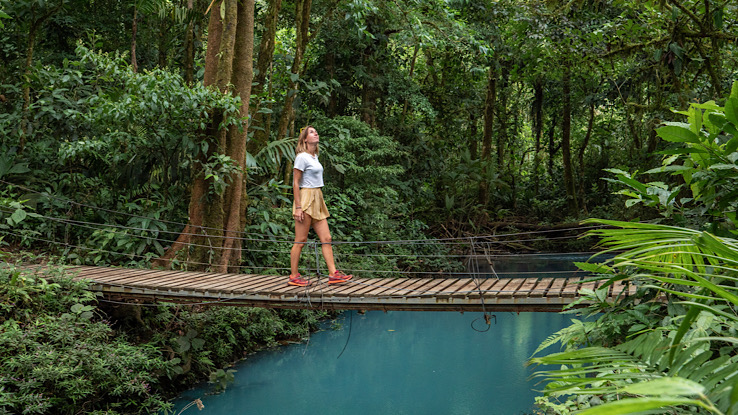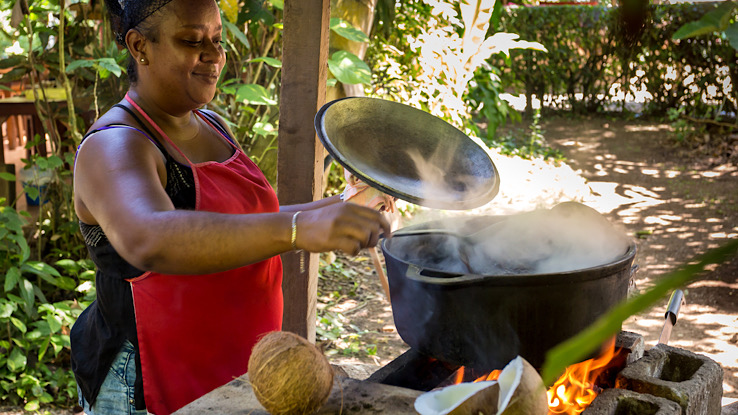
You’ll often hear the phrase Pura Vida when visiting Costa Rica. It means “pure life,” and not many countries follow that belief better than this Central American nation. The people’s warmth, connection to nature, and their commitment to environmentally-friendly ways of living are incredible. What better way to enjoy Pura Vida than ecotourism in Costa Rica, leaving a minor impact on the country while experiencing it to the fullest? So, let’s go green and see how to explore the “Rich Coast” in its purest form.
Why Ecotourism Matters For Costa Rica
Tourism is the country’s backbone, bringing in much more revenue than any other industry, representing over 5% of the GDP. Costa Rica nature tourism is a perfect fit with dozens of national parks, wildlife refuges, and biological reserves. The stunning jungles, volcanoes, beaches, and river systems are home to an incredible variety of animal and plant life, and the Costa Rican people have a deep respect and love for the land. Supporting sustainable travel is a win-win for tourists and locals alike, bringing money into the country, protecting natural resources, and connecting people with the environment.
Where To Stay
If you want to immerse yourself in ecotourism, Costa Rica is the ideal place. You can find luxury hotels that adhere to strict environmental standards, affordable lodging that is also some of the most sustainable, and eco-lodges on remote beaches or blending into the rainforest canopy. No matter where you decide to stay in the country, you can find places that meet Costa Rica’s sustainability initiatives. Some standout areas include:
Arenal Volcano National Park
This amazing volcanic wonderland offers hiking, biking, and horseback riding opportunities everywhere you look. There are many sustainable lodging options nearby, including Arenal Observatory Lodge & Spa (from $114 – $700 per night). It is surrounded by the park in an ideal location, uses sustainable maintenance, reforestation, and energy and water conservation practices, and it employs personnel from the locall from the local communities.
Corcovado National Park
This park is the pinnacle of ecotourism in Costa Rica. You can stay just outside the boundaries in eco-lodges with infinity pools or rustic options with solar power and comfortable, natural settings. An eco-lodge that stands above (literally, it is nestled high in the treetops) is Luna Lodge (between $200 – $580), which offers a beautiful setting and self-sufficient property with its own hydroelectric and solar power.
Monteverde Cloud Forest Reserve
To get a higher vantage point and an entirely different experience than the lower elevations, head to Monteverde Cloud Forest Reserve. Its eco-lodges sit among the clouds, giving visitors access to incredible wildlife and biodiversity. Try theMonteverde Lodge (from $203), settled between two major nature reserves, guaranteeing your immersion into a bird and animal paradise. Its sustainability practices include a biological gray water treatment plant and buying locally-sourced products, and it supports the local music festival and health fair.
Tortuguero National Park
This national park provides tropical beauty, environmentally-friendly lodging, and interactive opportunities to protect endangered wildlife. You can work with green turtles on the pristine beaches where they lay their eggs. One way to immerse yourself is at the Mawamba Lodge (from an affordable $115 per night). This riverfront resort encourages active explorations in nature, whether hiking, canoeing, kayaking, or observing and learning about the turtles. It is a highly-sustainable lodge with conservation practices across the board.
Culture & Food
Part of the draw of ecotourism in Costa Rica is immersing in the local culture and discovering what the place is all about. Sustainable travel often includes interacting with the people who live there authentically to feel the heartbeat of the land and its communities. As a bonus, you get to try new, delicious foods, giving you a more complete feel for a country. If you like friendly people and amazing, healthy food, you’ll love Costa Rica.
Local Culture
The vibe of the locals -“Ticos” – is as warm and welcoming as the weather, and you can easily connect with them and their culture. Whether you eat at Tico-owned restaurants, get to know guides and drivers, or ask for insight into people’s traditions, Costa Rica will welcome you. You can explore, relax, and socialize, knowing that your support benefits the people who live and work here. The country touches the Pacific Ocean and the Caribbean Sea, and its people reflect these unique and diverse regions: including indigenous groups, Spanish, Caribbean Islanders, Asians, and other immigrants. Its government is democratic, and it has no army, with a mellow and neighborly feel wherever you go.
Local Food

The food in Costa Rica is as diverse as its culture and includes everything from rice and beans to grilled fish to Latin sweets. Some amazing foods to try are:
- allo pinto – rice and beans
- hifrijo – fried pork with red beans
- ondón – a seafood stew sort of similar to cioppino, as cooks throw whatever they may have lying around into it
- Chorreadas – corn pancakes
Many foods tie into nature with organic, healthy choices and sustainably grown ingredients. And don’t forget to try the world-famous coffee! The warm, misty climate and the fertile volcanic soil are ideal for growing flavorful beans and excellent aromas.
How To Get Around
Costa Rica nature tourism is a snap. It is a small country, about the size of Denmark or Croatia, and there are many ways to travel that benefit the people. You will increasingly find electric and hybrid vehicles to get you from Point A to Point B while booking a guided tour means fewer rental cars on the road. Ecotourism is more than going green, though. It also means supporting and enhancing the local population, which you can do by booking homegrown tours, hiring Tico drivers, and planning your trip and travel to embrace the culture.
What To Do
For active travelers interested in ecotourism, Costa Rica is a paradise. You will discover so many nature-based activities that allow you to learn, explore, and get moving without the guilt of causing harm to the area. Some ideas include:
- Wildlife-spotting: You could spend months cataloging all the birds and animals you might see in places like Manuel Antonio National Park, but taking a few days hiking and looking for wildlife is a guaranteed good time.
- Extreme excitement: If zip-lining, rafting, mountain biking, or rappelling sound like fun, ArenalVolcano National Park is a great destination. You can support the country’s sustainability efforts by visiting, and you can stand in awe at the foot of an active (but currently sleeping) volcano.
- Hit the surf: Costa Rica is a world-famous surfing destination, with a wide variety of breaks for all skill levels. Knowing that your environmental footprint is small, you can enjoy the warm water and soothing sea.
- Go Birding: The sheer number of birds is jaw-dropping. You see and hear them everywhere, and birders from around the globe come here to observe them.
- Coffee-tasting: Visit one of the many coffee plantations to sample delicious Costa Rican coffee and support the people who run them.
Sustainable Travel Tips In Costa Rica
- Look for sustainability ratings. You can find out how hotels and lodges rank under the government’s Certification for Sustainable Tourism (CST) program or similar Blue Flag ratings.
- Get hands-on with volunteering. Help animals directly, volunteering to protect wildlife and rebuild habitats.
- Find eco-friendly tour companies. The CST program monitors tour operators, too. They give awards from 1-5 leaves so you can see who operates responsibly.
- Support the local culture. Several organizations showcase local artists, musicians, and dancers, putting on shows and events tourists can watch and support.






